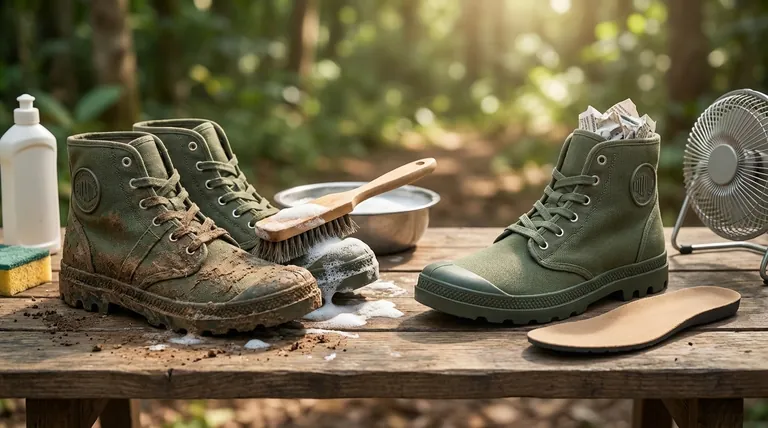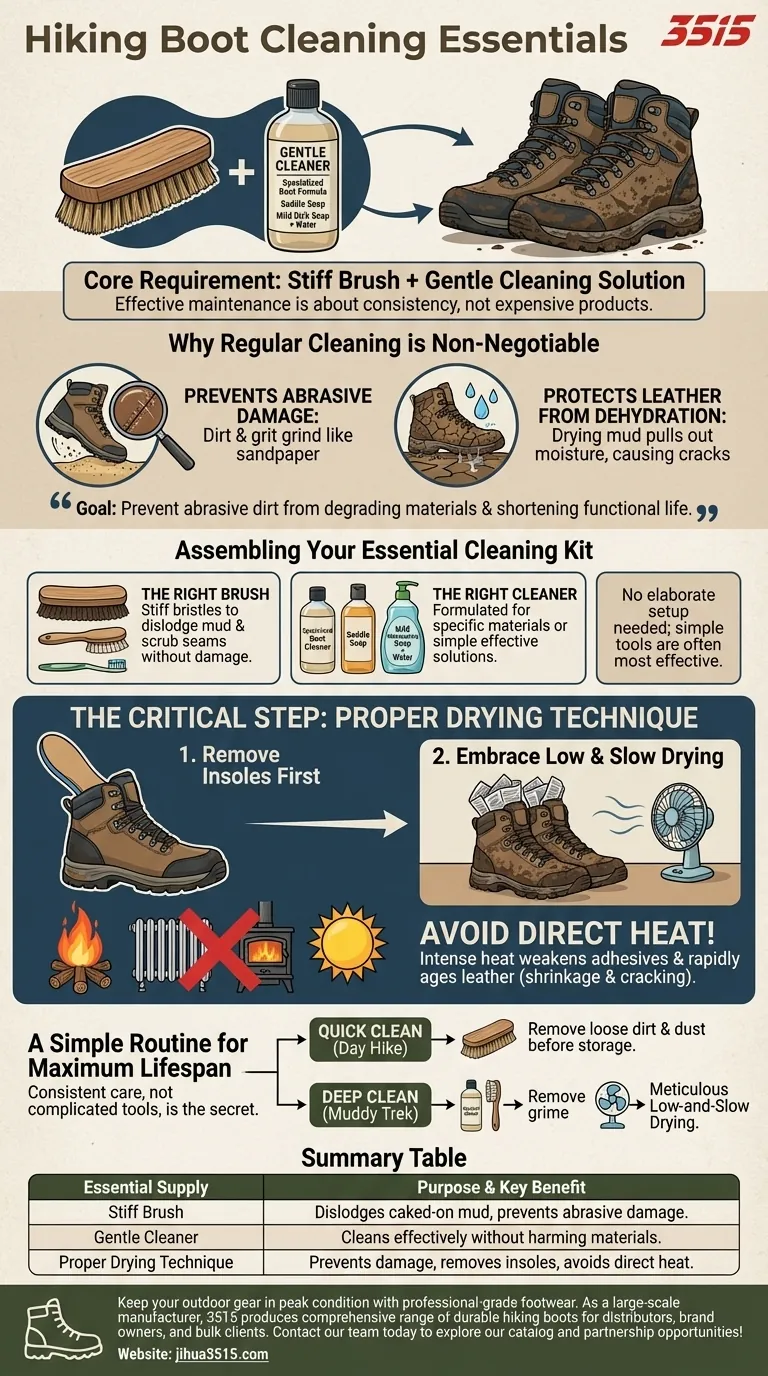At its core, cleaning your hiking boots requires just two simple tools: a stiff brush and a gentle cleaning solution. The specific cleaner can range from a specialized boot formula to a simple mix of mild dish soap and water, proving that effective maintenance is more about consistency than expensive products.
The real goal of cleaning your boots isn't just to make them look good. It's a critical maintenance routine that prevents abrasive dirt and caked-on mud from permanently degrading the materials and shortening the functional life of your gear.

Why Regular Cleaning is Non-Negotiable
Failing to clean your boots is one of the fastest ways to destroy them. The damage happens on a microscopic level every time you take a step in dirty footwear.
Preventing Abrasive Damage
Dried dirt, grit, and sand particles act like sandpaper. As the boot flexes with your foot, these abrasive particles grind away at the leather, synthetic fabrics, and stitching, causing premature wear and tear.
Protecting Leather from Dehydration
Mud is particularly damaging, especially to leather boots. As mud dries, it pulls essential moisture and oils out of the leather, leaving it dry, brittle, and prone to cracking.
Assembling Your Essential Cleaning Kit
You do not need an elaborate or expensive setup. The most effective tools are often the simplest and most accessible.
The Right Brush
A dedicated boot brush is ideal, but an old vegetable brush or even a toothbrush works perfectly well. The goal is to have bristles stiff enough to dislodge caked-on mud and scrub seams without damaging the boot's material.
The Right Cleaner
You have several effective options. Specialized boot cleaner is formulated for the specific materials in your footwear. Saddle soap is a classic choice for leather boots. In most cases, a simple solution of mild dishwashing soap and water is perfectly sufficient for a thorough cleaning.
The Critical Step: Proper Drying Technique
How you dry your boots is just as important as how you clean them. Improper drying can cause more damage than the hike itself.
Remove Insoles First
Always take the insoles out of your boots after cleaning. This allows the interior of the boot and the insoles themselves to dry completely, preventing odor and mildew.
Embrace Low and Slow Drying
Place your boots in a dry, well-ventilated area at a normal room temperature. To speed up the process, you can aim a fan at them or stuff them with newspaper, changing the paper every few hours as it becomes saturated.
Common Pitfalls to Avoid
The biggest mistake you can make in boot care involves the final step of the process. Your patience here will determine the lifespan of your gear.
The Dangers of Direct Heat
Never use a direct heat source to dry your boots. This includes campfires, radiators, wood stoves, or direct sunlight. Intense heat can weaken the adhesives that hold your boots together and will rapidly age leather, making it shrink and crack.
A Simple Routine for Maximum Lifespan
Integrate these steps into your post-hike routine to ensure your boots are always ready for the next adventure.
- If your goal is a quick clean after a day hike: Focus on using your brush to remove all loose dirt and dust before storing your boots.
- If your goal is a deep clean after a muddy trek: Use a cleaning solution and brush to remove all grime, then follow the low-and-slow drying method meticulously.
Consistent care, not complicated tools, is the true secret to gear that lasts.
Summary Table:
| Essential Supply | Purpose & Key Benefit |
|---|---|
| Stiff Brush | Dislodges caked-on mud and dirt to prevent abrasive damage to materials and stitching. |
| Gentle Cleaner | Effectively cleans without harming materials. Options include specialized boot cleaner, saddle soap, or mild dish soap and water. |
| Proper Drying Technique | Crucial for preventing damage. Involves removing insoles and air-drying at room temperature, avoiding direct heat sources. |
Keep your outdoor gear in peak condition with professional-grade footwear. As a large-scale manufacturer, 3515 produces a comprehensive range of durable hiking boots and outdoor footwear for distributors, brand owners, and bulk clients. Our production capabilities ensure high-quality, long-lasting products built for adventure. Let's discuss your footwear needs — contact our team today to explore our catalog and partnership opportunities!
Visual Guide

Related Products
- Factory-Direct Wholesale Canvas Boots with High-Traction Rubber Soles
- Wholesale High-Traction Camo Boots - Custom Manufacturer for Brands
- Safety Footwear Wholesale Manufacturer for Custom OEM/ODM Production
- Factory Direct Wholesale Rain Boots Durable Waterproof & Fully Customizable
- High Performance Fire-Retardant Waterproof Safety Boots
People Also Ask
- Why are rubber soles beneficial in cold-weather boots? Superior Traction & Waterproofing
- What role do slip-resistant rubber materials play in safety shoes? Ensuring Grip and Stability in Hazardous Workplaces
- Why is rubber commonly used for non-slip soles? The Science of Superior Grip
- What types of work environments are hiker-style rubber outsoles best for? Ideal for Outdoor & Industrial Safety
- What is a vulcanized sole? Discover the Secret to Superior Flexibility and Grip



















